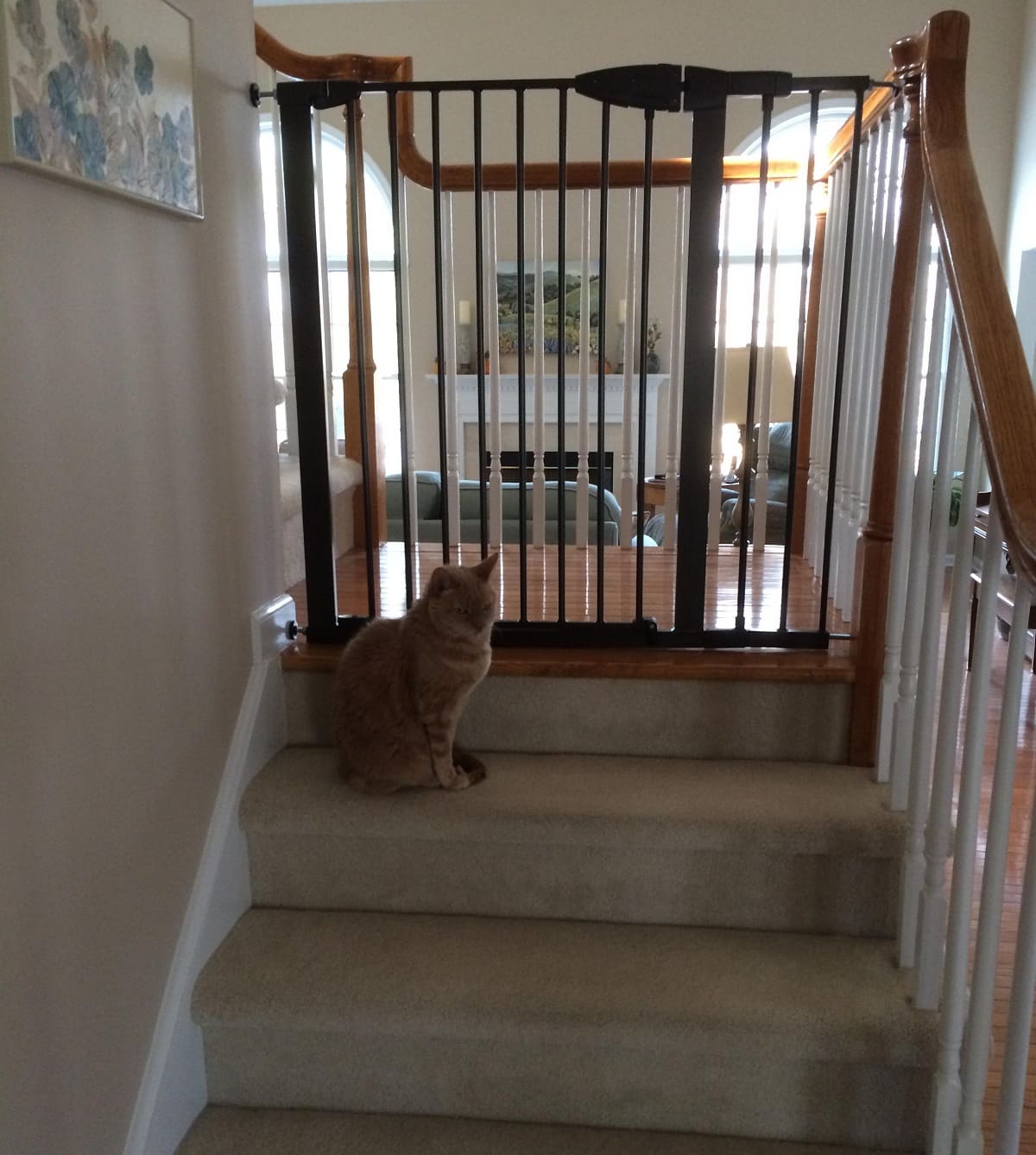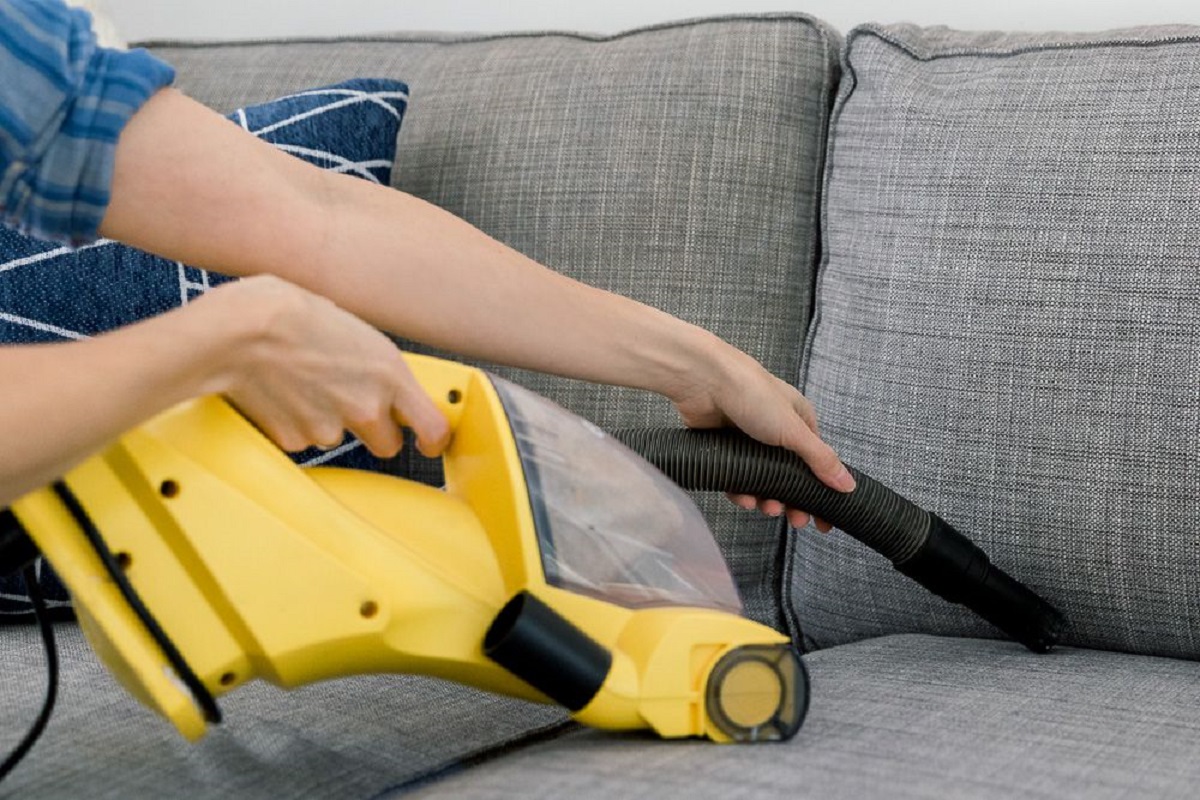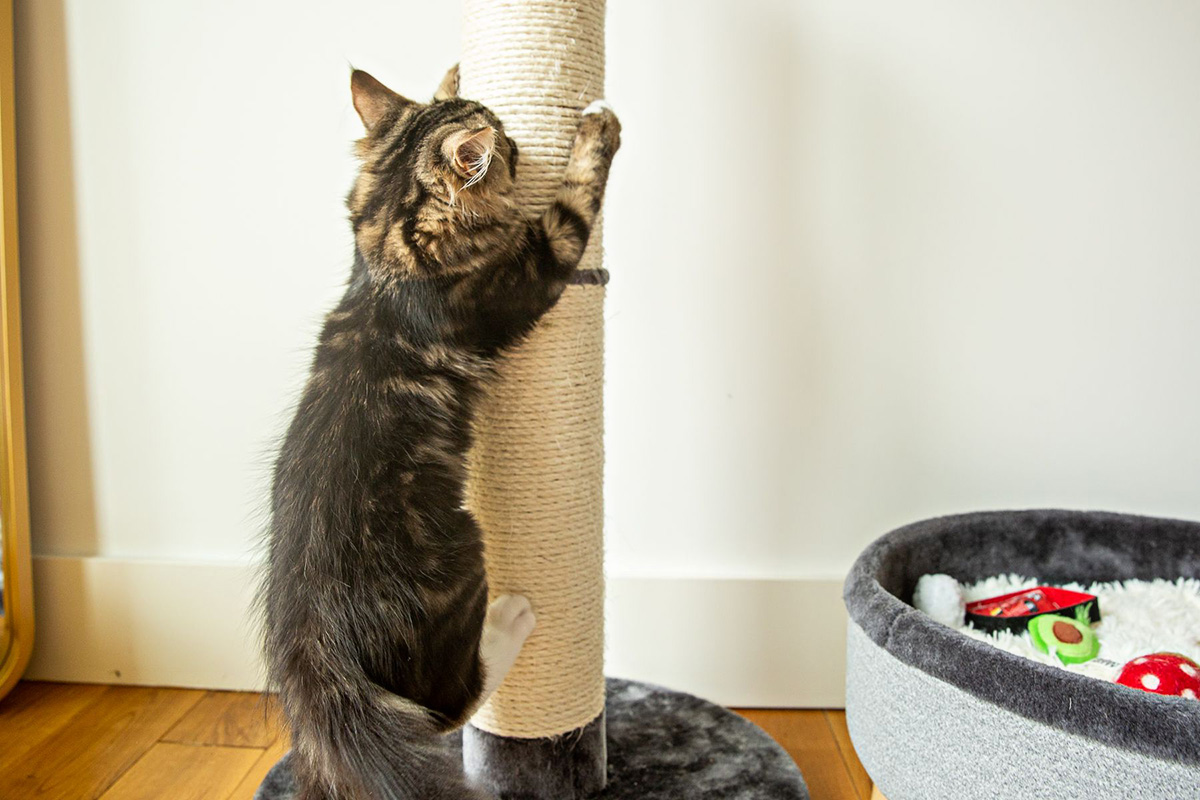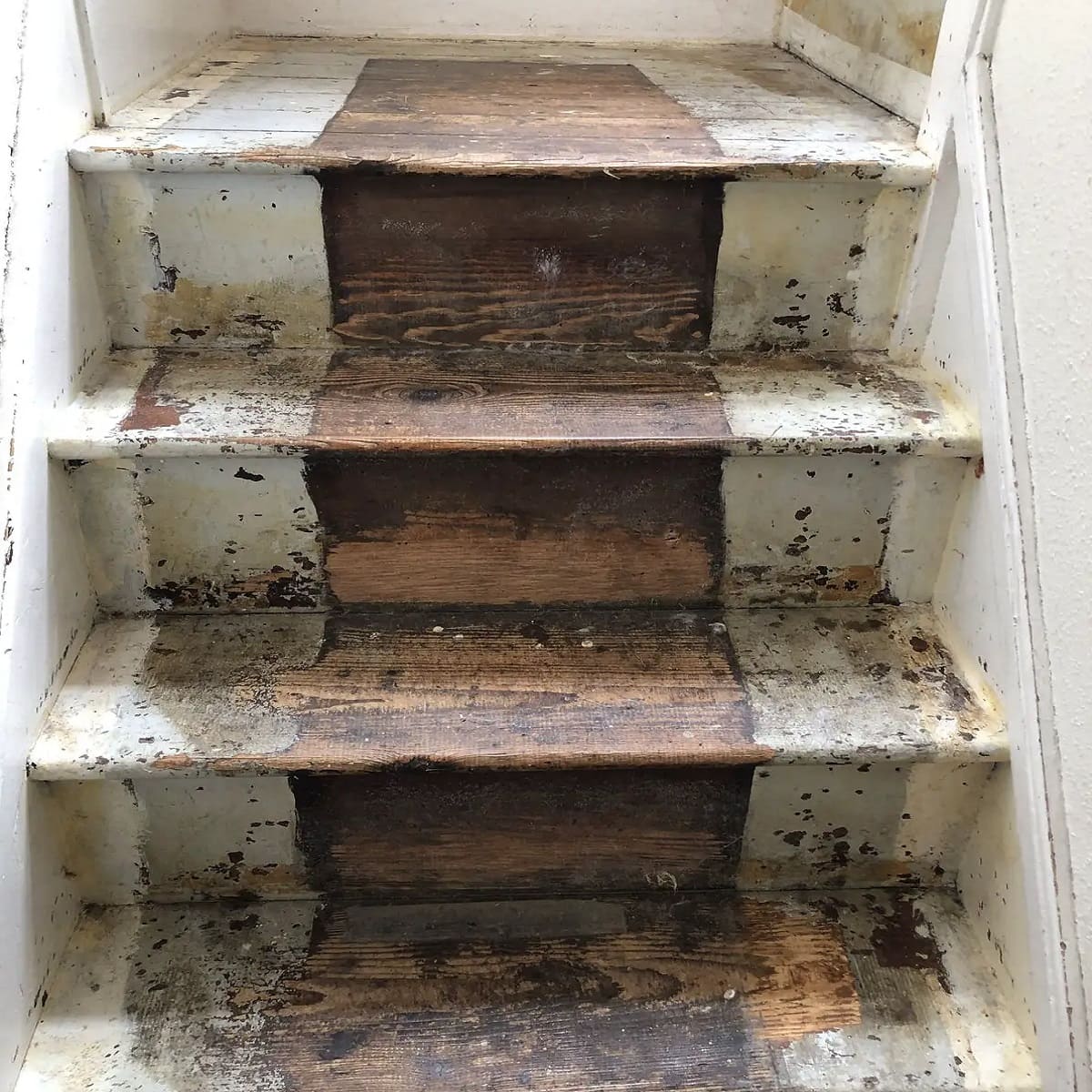

Articles
How To Block Cats From Stairs
Modified: May 6, 2024
Looking to keep your stairs cat-free? Check out our informative articles on how to block cats from accessing your stairs and keep them safe.
(Many of the links in this article redirect to a specific reviewed product. Your purchase of these products through affiliate links helps to generate commission for Storables.com, at no extra cost. Learn more)
Introduction:
Having cats as pets can bring joy, companionship, and a sense of comfort to our lives. However, there may be instances where we need to block access to certain areas, such as stairs, to ensure their safety and prevent any unwanted accidents. Whether you have a curious kitten or an adventurous feline, finding effective ways to block cats from stairs is essential.
In this article, we will explore various methods and techniques to successfully keep cats away from stairs. By understanding the problem, assessing the situation, and implementing appropriate solutions, you can create a safe environment for your furry friends while maintaining the integrity of your staircase.
Let’s dive into the details and discover how you can block cats from stairs and effectively address this common concern for cat owners.
Key Takeaways:
- Safeguard your furry friends by understanding their motivations, setting clear boundaries, and using physical barriers, deterrents, and distractions to block cats from stairs. Consistency and patience are key to success.
- If your efforts to deter cats from stairs are unsuccessful, seek professional help from a cat behaviorist or veterinarian. Tailored solutions and expert guidance can address underlying issues and ensure your cat’s safety.
Read more: How To Block Stairs Without A Gate
Understanding the Problem:
Before delving into the various methods to block cats from stairs, it is important to understand why cats are drawn to this area in the first place. Cats are naturally curious and agile animals, always seeking new environments to explore and conquer. Stairs provide a perfect platform for them to display their acrobatic abilities and satisfy their adventurous instincts.
However, allowing unrestricted access to stairs can pose several risks to your furry companion. Cats may accidentally slip and fall, leading to injuries such as sprains, fractures, or even more serious consequences. Additionally, if you have a multi-level home, cats roaming freely on the stairs can increase the chances of accidents, such as tripping or stepping on them accidentally.
Understanding the potential dangers associated with cats on stairs is crucial for prioritizing their safety and well-being. By recognizing the underlying reasons behind their attraction to this area, you can effectively address the problem and implement appropriate solutions.
Common reasons why cats are drawn to stairs include:
- Curiosity: Cats are naturally curious creatures and are often intrigued by new spaces to explore. The unique design and structure of stairs may captivate their attention.
- Heightened Perch: Cats are known to seek elevated perches to observe their surroundings and ensure their safety. Stairs provide an ideal vantage point for this purpose.
- Exercise and Play: Stairs can serve as a playground for cats, allowing them to engage in physical activities, such as running up and down, sharpening their claws, or playing with toys.
- Traffic Flow: In households with multiple pets, stairs can act as a primary route for cats to move between levels or access certain areas.
By understanding these underlying motivations, you can develop effective strategies to block cats from stairs and redirect their attention towards safer alternatives.
Assessing the Situation:
Once you have a clear understanding of why cats are drawn to the stairs, the next step is to assess the specific situation in your home. Every household is unique, and factors such as the layout of the stairs, the behavior of your cat, and the presence of other pets will influence the most suitable approach to block cats from stairs.
Here are some key considerations when assessing the situation:
- Staircase Design: Take note of the design and structure of your staircase. Are there open gaps or spaces where your cat can easily climb through? Are there any narrow or steep areas that may pose a higher risk?
- Cat’s Behavior: Observe your cat’s behavior around the stairs. Does your cat frequently attempt to climb the stairs or explore this area? Understanding their habits will help you identify the most effective strategies to deter them.
- Other Pets: Consider the dynamics between your cat and any other pets in your home, especially if they share access to the stairs. This will help determine if you need to implement additional measures to ensure each animal’s safety.
- Accessibility Needs: Assess whether there are any areas on the staircase that your cat may still need to access, such as a litter box or a favorite hiding spot. Blocking off the entire staircase may not be feasible in certain situations.
By carefully evaluating these factors, you can tailor your approach to suit your specific circumstances and effectively block cats from stairs while taking into account their individual needs.
It is essential to approach the situation with a combination of safety measures, behavioral modifications, and environmental adjustments to create a holistic solution that meets the unique requirements of your cat and your home.
With a solid understanding of the problem and a comprehensive assessment of the situation, you are now ready to explore different strategies to block cats from stairs. Let’s proceed to the next section to discover the practical methods you can implement for a safer environment.
Setting Clear Boundaries:
One of the fundamental steps to block cats from stairs is to establish clear boundaries and communicate them effectively to your furry friend. By defining the areas that are off-limits, you can ensure their safety while minimizing potential accidents or damage to your staircase.
Here are some strategies to set clear boundaries:
- Physical Barriers: Install gates or barriers at the top and bottom of the staircase to restrict access. There are various types of cat-friendly gates available that can be easily installed and provide a physical barrier to prevent cats from climbing the stairs.
- Closed Doors: If possible, keep the doors to the staircases closed, preventing your cat from even getting near the stairs. This method works well for single-level homes or areas with limited access.
- Training and Reinforcement: Use training techniques to teach your cat to stay away from the stairs. Positive reinforcement, such as treats or praise, can be effective in associating the staircase with a negative consequence or redirecting their attention to a more suitable location.
- Visual Indicators: Place visual indicators, such as sticky tape or aluminum foil, on the stairs to discourage your cat from approaching. Cats dislike the texture or sound, serving as a deterrent to keep them away.
Remember, consistency is key when setting boundaries for your cat. Continually reinforce the desired behavior and redirect them to appropriate areas to help them understand and respect the established boundaries.
It is important to note that setting boundaries alone may not be sufficient for highly determined or agile cats. In such cases, additional measures may need to be implemented to effectively block cats from stairs.
Now that we have laid the groundwork by setting clear boundaries, let’s move on to explore other strategies and techniques to deter cats from accessing the stairs. By employing a combination of approaches, you can increase the effectiveness of your efforts and create a secure environment for your beloved feline companion.
Using Physical Barriers:
Physical barriers are an effective way to block cats from stairs, providing a tangible obstacle that prevents them from accessing the area. There are various types of barriers available, each with its own benefits and considerations.
Here are some options for using physical barriers:
- Cat Gates: Install cat gates at the top and bottom of the staircase. Cat gates are designed specifically for pets and provide a secure barrier without blocking airflow or obstructing visibility. Make sure to choose a gate that is tall enough to prevent your cat from jumping over or squeezing through. Opt for gates with a secure locking mechanism that cannot be easily opened by your cat.
- Pet-Proof Fencing: If you have an open-concept staircase or need to block access to a larger area, consider installing pet-proof fencing. This type of fencing is made with small gaps or solid panels, ensuring that your cat cannot slip through or jump over the barrier. It can be installed permanently or used as temporary fencing when needed.
- Plexiglass or Acrylic Sheets: For a more discreet option, you can attach plexiglass or acrylic sheets to the openings of the stairs. These clear panels provide a barrier while still allowing light to pass through and maintaining the aesthetics of your staircase. Ensure that the sheets are securely fastened and the edges are smooth to prevent any injuries.
- DIY Barriers: If you’re on a budget or prefer a more customized approach, you can create your own barriers using materials such as mesh screening, plywood, or plexiglass. Measure the area that needs to be blocked, cut the material to size, and secure it in place using hooks, brackets, or zip ties.
When using physical barriers, it is crucial to ensure that they are stable, secure, and properly installed. Regularly check for any damage or wear and tear to maintain their effectiveness over time. Additionally, consider the aesthetics and functionality of the barrier to ensure it aligns with your home’s design and the needs of your cat.
Physical barriers can be a reliable and straightforward solution to block cats from stairs, providing peace of mind and ensuring the safety of your feline friend. However, they may not be suitable for all households or situations. In the next section, we will explore additional methods to deter cats from accessing the stairs, complementing the use of physical barriers.
Consider installing a baby gate at the top and bottom of the stairs to block cats from accessing them. Make sure the gate is tall enough to prevent them from jumping over.
Read also: 8 Best Cat Stairs For 2025
Creating Deterrents:
In addition to physical barriers, creating deterrents can be an effective strategy to discourage cats from accessing the stairs. Deterrents work by making the area unappealing or uncomfortable for cats, thus redirecting their attention to alternative spaces.
Here are some deterrents you can employ:
- Double-Sided Tape: Place double-sided tape along the edges of the stairs. Cats dislike the sticky texture and will avoid walking on it. However, make sure to choose a tape that is safe for your staircase and easy to remove without causing any damage.
- Scents and Repellents: Cats have sensitive noses and can be deterred by certain scents. Sprinkle citrus peels or spray citrus-scented air fresheners near the stairs. You can also use pet-safe repellents that are specifically designed to deter cats from certain areas. Be sure to choose a repellent that is safe for indoor use and follow the manufacturer’s instructions.
- Motion-Activated Devices: Install motion-activated devices near the stairs, such as air canisters or sprays. These devices emit a sudden burst of air or noise when triggered by a cat’s movement, startling them and encouraging them to stay away from the stairs.
- Aluminum Foil and Tin Cans: Cats dislike the noise and texture produced by aluminum foil or tin cans. Place these items strategically around the stairs to create a deterrent. The noise and uncertainty they create can discourage cats from approaching or climbing the stairs.
- Ultrasonic Repellents: Ultrasonic devices emit high-frequency sounds that are unpleasant to cats but inaudible to human ears. These devices can be placed near the stairs to deter cats effectively without causing harm. It is important to select a device that is specifically designed for use around pets.
Remember to choose deterrents that are safe for your cat and your home. Avoid using any substances or devices that may harm or cause stress to your furry friend. Regularly assess the effectiveness of the deterrents and make adjustments as needed.
By implementing these deterrent methods, you can create an environment that discourages cats from approaching or climbing the stairs. However, it is important to remember that deterrents alone may not be enough for some determined cats. In the next section, we will explore additional techniques, such as training and distractions, to complement the use of deterrents and reinforce positive behaviors.
Using Audio and Visual Distractions:
Another effective approach to block cats from stairs is by using audio and visual distractions. By redirecting their attention to alternative stimuli, you can deter cats from accessing the stairs and keep them engaged in more suitable activities.
Here are some methods to use audio and visual distractions:
- White Noise Machines: Install a white noise machine or play soothing background music near the stairs. The continuous sound can help mask any noises that may attract your cat’s attention and redirect their focus to a more calming environment.
- Visual Deterrents: Place visual deterrents near the stairs that can startle or confuse your cat. This can include objects like inflatable scarecrows, hanging wind chimes, or spinning toys. The movement and unfamiliarity of these objects can discourage cats from approaching or climbing the stairs.
- Interactive Toys: Provide interactive toys or puzzle feeders in areas away from the stairs to keep your cat mentally stimulated and physically engaged. These toys can help redirect their energy and curiosity towards more appropriate activities.
- TV or Videos: Play nature or bird videos on the TV or a tablet near the stairs. Cats are visually stimulated animals, and watching captivating videos can captivate their attention and distract them from wanting to explore the stairs.
- Catnip and Toys: Sprinkle catnip on scratching posts or interactive toys placed away from the stairs. Catnip can provide cats with a sensory distraction, encouraging them to focus their energy on these designated areas rather than the stairs.
When using audio and visual distractions, it’s important to select stimuli that are safe and engaging for your cat. Monitor their response and adjust the distractions accordingly to maintain their effectiveness.
Additionally, remember that these distractions are meant to redirect your cat’s attention and energy, but they may not work for all cats. In some cases, a combination of distractions and training techniques may be necessary to achieve the desired results.
In the next section, we will discuss training techniques that can further reinforce positive behaviors and discourage cats from accessing the stairs.
Implementing Training Techniques:
Training techniques play a crucial role in teaching cats appropriate behavior and can be valuable in blocking their access to stairs. By consistently reinforcing positive behaviors and providing alternatives, you can effectively train your cat to stay away from the stairs.
Here are some training techniques to consider:
- Positive Reinforcement: Use positive reinforcement to reward your cat for staying away from the stairs. When your cat exhibits the desired behavior, such as staying in designated areas or using alternative routes, praise them, offer treats, or use a clicker to mark the behavior. This positive association will motivate your cat to repeat the behavior.
- Redirecting Attention: When you notice your cat heading towards the stairs, redirect their attention to a more suitable activity or location. Use toys, treats, or interactive play to engage your cat in a positive and stimulating way. This will help steer their focus away from the stairs and towards a more appropriate area.
- Clicker Training: Clicker training is a technique that uses a clicker to mark desired behaviors. By associating the sound of the clicker with a reward, you can train your cat to understand which behaviors are desirable. Use the clicker to reward your cat whenever they avoid the stairs or follow a designated path.
- Target Training: Use target training to teach your cat to go to specific areas away from the stairs. Place a target, such as a mat or a designated spot, and reward your cat whenever they go to that area. Gradually move the target further away from the stairs to redirect their attention and reinforce the desired behavior.
- Environmental Enrichment: Make sure your cat’s environment is enriched with various toys, scratching posts, and interactive play areas. This will help keep them mentally stimulated and physically engaged, reducing their desire to explore the stairs.
Consistency, patience, and positive reinforcement are key when implementing training techniques. Working with your cat’s natural behaviors and reinforcing positive alternatives will help them understand and respect the boundaries you have set.
Keep in mind that training takes time and each cat is unique. Some cats may respond quickly to training, while others may require more time and repetition. Monitor their progress and adjust your training techniques accordingly.
By incorporating training techniques into your approach, you can effectively block cats from stairs and foster positive behaviors that will ensure their safety and well-being.
Seeking Professional Help:
If you have tried various methods to block cats from stairs without success or if your cat’s behavior around the stairs is causing significant concern or safety risks, it may be beneficial to seek professional help. A professional cat behaviorist or veterinarian can provide expert guidance and tailored solutions to address the specific challenges you are facing.
Here are some reasons why seeking professional help may be beneficial:
- Expert Evaluation: A professional can assess the situation, understand the underlying causes of your cat’s behavior, and provide an accurate diagnosis. They can identify any potential medical issues or underlying anxieties that may be contributing to your cat’s attraction to the stairs.
- Tailored Solutions: A cat behaviorist or veterinarian can customize a behavior modification plan based on your cat’s individual needs and your home environment. They can recommend specific training techniques, environmental adjustments, and other strategies to effectively block your cat from accessing the stairs.
- Medication or Supplements: In some cases, medication or supplements may be recommended to help address underlying anxieties or compulsive behaviors that are driving your cat’s attraction to the stairs. A professional can prescribe or recommend appropriate options to help alleviate these issues.
- Professional Training: Working with a professional can ensure that you are using training techniques correctly and consistently. They can guide you through the training process, provide feedback, and help troubleshoot any challenges that may arise.
- Peace of Mind: Seeking professional help can provide reassurance and peace of mind, knowing that you are taking the necessary steps to address your cat’s behavior and ensure their safety. Professionals have the expertise and experience to guide you through the process and offer support along the way.
Remember to choose a reputable and qualified professional who specializes in cat behavior and has experience in addressing similar issues. They should have a thorough understanding of feline behavior and be able to provide personalized solutions tailored to your specific situation.
By seeking professional help, you can gain valuable insights, guidance, and support in effectively blocking cats from stairs and addressing any underlying behavioral issues.
Read more: How To Block Heat From Skylight
Conclusion:
Blocking cats from stairs is essential for their safety and the prevention of accidents in your home. By implementing a combination of strategies, you can successfully deter cats from accessing the stairs while providing them with alternative options for play and exploration.
Throughout this article, we have explored various methods to block cats from stairs, including setting clear boundaries, using physical barriers, creating deterrents, implementing training techniques, and seeking professional help when needed.
Understanding the problem, assessing the specific situation in your home, and tailoring your approach to meet your cat’s needs are key steps in effectively addressing this issue. Whether it’s through the use of gates, training techniques, environmental adjustments, or seeking professional guidance, there are numerous tools at your disposal to keep your cat safe and away from the stairs.
Remember to approach the process with patience and consistency. Consistently reinforcing positive behaviors, providing engaging alternatives, and using positive reinforcement will help your cat understand and respect the boundaries you have set.
If you find that your efforts are not yielding the desired results or your cat’s behavior around the stairs is causing significant concern, seeking professional help from a cat behaviorist or veterinarian is an excellent option. They can provide expert guidance, customized solutions, and professional training to address your specific situation.
Ultimately, by taking the necessary steps to block cats from stairs, you can create a safe environment for your feline companion while minimizing the risk of accidents or injuries. By understanding their behaviors, implementing effective techniques, and providing a stimulating environment, you can ensure their well-being and foster a harmonious living space for both you and your furry friend.
After mastering how to keep cats off your stairs, why not teach your pet another impressive trick? If you're intrigued by the idea of less litter and easier clean-up, our next guide on feline bathroom habits is a must-read. You'll discover practical steps on how to efficiently train your cat to use the toilet, transforming daily routines for both you and your pet. This change not only simplifies cleaning but also promotes a more hygienic home environment.
Frequently Asked Questions about How To Block Cats From Stairs
Was this page helpful?
At Storables.com, we guarantee accurate and reliable information. Our content, validated by Expert Board Contributors, is crafted following stringent Editorial Policies. We're committed to providing you with well-researched, expert-backed insights for all your informational needs.














0 thoughts on “How To Block Cats From Stairs”